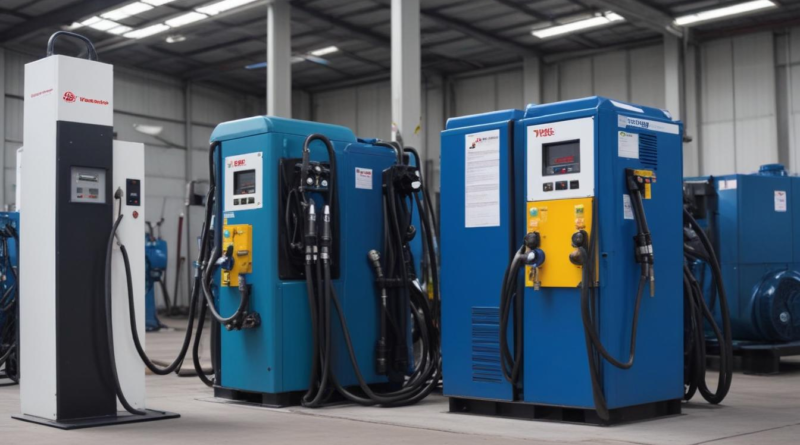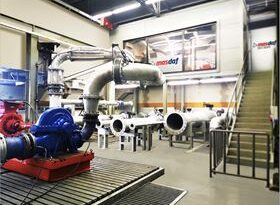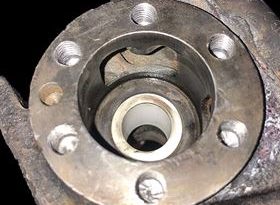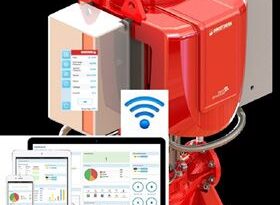comparison between electric and diesel pumps
Operational efficiency is a critical factor when evaluating the performance of electric pumps versus diesel pumps. This comparison highlights several key aspects, including energy conversion efficiency, responsiveness, and adaptability to different operational demands.
Electric pumps are renowned for their high energy conversion efficiency. Typically, electric motors convert approximately 90% of electrical energy into mechanical energy, minimizing energy loss. In contrast, diesel pumps generally exhibit lower efficiency, with energy conversion rates around 35-40%. This discrepancy is primarily due to the inherent inefficiencies in the internal combustion process and the mechanical complexity of diesel engines.
| Aspect | Electric Pumps | Diesel Pumps |
|---|---|---|
| Energy Conversion Efficiency | ~90% | 35-40% |
| Power Response Time | Immediate start and steady output | Slower start-up, fluctuating output |
| Operational Flexibility | Highly adaptable to varying loads | Less adaptable, efficiency drops under variable loads |
The responsiveness of electric pumps is another area where they excel. Electric pumps can achieve full operational capacity almost instantaneously, making them ideal for applications requiring rapid response and consistent performance. Diesel pumps, however, require a startup period to reach optimal operational speeds, which can be a limitation in scenarios where immediate pump activation is necessary.
- Electric Pumps:
- Provide consistent flow rates and pressure levels.
- Maintain efficiency across a wide range of operating conditions.
- Suitable for continuous operation without performance degradation.
- Diesel Pumps:
- Performance can vary with engine load and fuel quality.
- Efficiency decreases during partial load operations.
- Susceptible to fluctuations in power output under variable demands.
Furthermore, the adaptability of electric pumps to different operational demands is a significant advantage. Their ability to maintain high efficiency across varying loads ensures optimal performance in diverse applications, from industrial processes to municipal water supply systems. Diesel pumps, while robust and capable of operating independently of the electrical grid, often experience reduced efficiency when not operating at full capacity, leading to increased fuel consumption and higher operational costs.
In summary, the operational efficiency of electric pumps generally surpasses that of diesel pumps, particularly in applications requiring consistent and reliable performance. The higher energy conversion efficiency, rapid responsiveness, and adaptability to variable loads make electric pumps a more efficient choice in many scenarios, despite the typically higher initial investment costs associated with electric systems.
energy consumption
Energy consumption is a pivotal consideration in the comparison between electric pumps and diesel pumps. Understanding the energy requirements and efficiencies of each pump type is essential for making informed decisions regarding operational costs, sustainability, and overall system performance.
Electric pumps primarily rely on electrical energy, which can be sourced from various means, including the electrical grid, renewable energy sources, or on-site generators. The energy consumption of electric pumps is generally measured in kilowatts (kW) and is directly related to the pump’s power rating and operational hours. One of the significant advantages of electric pumps is their high energy conversion efficiency, often reaching up to 90%. This means that a substantial portion of the electrical energy is effectively utilized for mechanical work, with minimal losses.
In contrast, diesel pumps operate on diesel fuel, and their energy consumption is typically measured in liters per hour (L/hr) or gallons per hour (GPH). The energy conversion efficiency of diesel pumps is noticeably lower, averaging around 35-40%. The internal combustion process inherent to diesel engines results in significant energy losses, primarily in the form of heat and mechanical friction. Additionally, diesel pumps require fuel storage and supply systems, which add to the complexity and energy demands of the setup.
| Energy Consumption Aspect | Electric Pumps | Diesel Pumps |
|---|---|---|
| Energy Source | Electricity (grid, renewable, generators) | Diesel fuel |
| Efficiency | ~90% | 35-40% |
| Energy Measurement | kW and kWh | L/hr or GPH |
| Operational Energy Loss | Minimal due to high conversion efficiency | Significant due to combustion inefficiencies |
| Energy Cost Stability | Generally more stable, dependent on electricity rates | Variable, influenced by fuel prices |
Cost Implications: The cost of energy is a crucial factor in determining the operational expenses associated with each pump type. Electric pumps benefit from lower and more stable energy costs, especially when powered by renewable energy sources. The efficiency of electric motors ensures that less energy is required to perform the same amount of work compared to diesel pumps, translating to reduced energy bills over time. Moreover, electricity prices are generally more predictable, allowing for better budgeting and financial planning.
Diesel pumps, on the other hand, are subject to fluctuating fuel prices, which can significantly impact operational costs. The lower energy conversion efficiency means that more fuel is required to achieve the same pumping capacity as electric pumps, leading to higher ongoing expenses. Additionally, the need for regular fuel deliveries and storage adds to the logistics and costs associated with diesel pump operations.
Environmental Considerations: The source and type of energy consumed by pumps also have environmental implications. Electric pumps, especially those powered by renewable energy sources such as solar or wind, offer a more sustainable and environmentally friendly solution. They produce no direct emissions during operation, contributing to reduced greenhouse gas emissions and a smaller carbon footprint.
Diesel pumps, conversely, emit carbon dioxide (CO₂), nitrogen oxides (NOₓ), and other pollutants during combustion, which contribute to air pollution and climate change. The reliance on fossil fuels not only impacts the environment but also reinforces the importance of transitioning to cleaner energy alternatives where feasible.
- Electric Pumps:
- Lower long-term energy costs due to high efficiency.
- Potential for integration with renewable energy systems.
- Stable energy pricing reduces financial uncertainty.
- Diesel Pumps:
- Higher operational costs driven by fuel consumption.
- Vulnerable to fuel price volatility and supply disruptions.
- Increased environmental regulations may impose additional costs.
Scalability and Load Management: Electric pumps offer greater flexibility in scaling operations and managing varying loads efficiently. Their ability to maintain consistent energy consumption across different operational levels ensures optimal performance and energy usage, regardless of the demand fluctuations. This adaptability is particularly beneficial in applications where pump usage varies over time, such as in municipal water systems or industrial processes.
Diesel pumps often struggle with efficiency when dealing with partial loads. Operating below their optimal capacity can lead to disproportionately higher fuel consumption and reduced overall efficiency. This makes diesel pumps less suitable for applications with variable demand, as energy consumption can become erratic and harder to manage effectively.
Operational Hours and Demand: The energy consumption patterns of electric and diesel pumps also differ based on operational hours and demand cycles. Electric pumps are ideal for continuous operation scenarios, where their consistent energy usage and high efficiency result in stable energy consumption profiles. They can run for extended periods without significant increases in energy consumption, making them suitable for applications requiring prolonged and reliable pumping capabilities.
Diesel pumps are often employed in backup or emergency situations due to their portability and independence from the electrical grid. However, when used for extended periods, their high fuel consumption rates can lead to substantial energy usage and increased operational costs. For applications requiring intermittent or emergency use, diesel pumps may be more energy-efficient, but they are generally less suitable for continuous operations.
In summary, the energy consumption comparison between electric and diesel pumps highlights significant differences in efficiency, cost stability, and environmental impact. Electric pumps typically offer higher energy conversion efficiency, lower and more predictable energy costs, and greater environmental benefits, making them a more sustainable and cost-effective choice for many applications. Diesel pumps, while useful in specific contexts requiring portability and grid independence, generally incur higher energy consumption and costs, along with greater environmental challenges.
maintenance and reliability
Maintenance and reliability play a vital role in the ongoing performance and longevity of both electric and diesel pumps. Understanding the maintenance requirements and reliability factors associated with each pump type is essential for ensuring uninterrupted operations and minimizing downtime.
Electric pumps generally exhibit higher reliability due to their simpler mechanical design. With fewer moving parts and absence of an internal combustion engine, electric pumps experience less wear and tear, leading to fewer failures and longer service intervals. Regular maintenance for electric pumps typically involves:
- Inspection of electrical connections: Ensuring all wiring and connections are secure and free from corrosion.
- Lubrication of moving components: Applying appropriate lubricants to bearings and other moving parts to reduce friction.
- Monitoring motor performance: Checking for signs of overheating or unusual noise that may indicate emerging issues.
- Routine cleaning: Keeping the pump and its surroundings free from debris and contaminants to prevent blockages and wear.
In contrast, diesel pumps require more intensive maintenance due to the complexities of the internal combustion engine. Maintenance tasks for diesel pumps include:
- Engine servicing: Regular oil changes, filter replacements, and inspection of fuel lines to ensure optimal engine performance.
- Cooling system maintenance: Checking and maintaining coolant levels, hoses, and radiator components to prevent overheating.
- Exhaust system checks: Inspecting exhaust pipes and mufflers for leaks or blockages that could affect engine efficiency.
- Fuel system maintenance: Cleaning and servicing fuel injectors and ensuring fuel quality to prevent engine wear.
Reliability Comparison:
| Aspect | Electric Pumps | Diesel Pumps |
|---|---|---|
| Mean Time Between Failures (MTBF) | Higher MTBF due to fewer moving parts | Lower MTBF due to engine and fuel system complexities |
| Downtime | Minimal downtime with straightforward maintenance | Increased downtime for engine repairs and maintenance |
| Maintenance Frequency | Less frequent maintenance required | More frequent and intensive maintenance needed |
| Parts Availability | Readily available electronic components and motor parts | Requires access to specialized engine parts and expertise |
| Operational Reliability | Consistently reliable with stable power supply | Reliability can be affected by fuel quality and engine condition |
Cost Implications: The maintenance costs associated with electric pumps are generally lower compared to diesel pumps. Electric pumps require fewer consumables, such as lubricants and filters, and their simpler design reduces the need for specialized maintenance skills. Additionally, the extended intervals between maintenance activities contribute to lower overall maintenance expenses.
Diesel pumps, however, incur higher maintenance costs due to the need for regular engine servicing, replacement of more frequent wear parts, and the necessity for skilled technicians to perform complex repairs. The ongoing costs of fuel storage and handling also add to the total maintenance expenses for diesel pump systems.
Reliability Factors: Electric pumps are often favored in applications where reliability and continuous operation are critical. Their ability to operate with minimal maintenance and their resilience against environmental factors make them suitable for essential services such as water supply and industrial processes.
Diesel pumps, while robust and capable of operating independently of the electrical grid, are typically used in applications where backup power is necessary or where access to electrical infrastructure is limited. Their reliability, however, can be compromised by factors such as fuel quality, engine wear, and operational stresses, making them less suitable for continuous, high-demand scenarios.
Technology Advancements: Advances in electric pump technology, including the development of more durable materials and smart monitoring systems, have further enhanced their reliability and reduced maintenance requirements. Predictive maintenance technologies, such as IoT sensors and real-time monitoring, allow for proactive identification of potential issues, thereby minimizing unexpected downtime.
Diesel pump technology has also seen improvements, particularly in engine efficiency and emissions control. However, the inherent complexities of internal combustion engines continue to necessitate more extensive maintenance compared to electric pumps.
Environmental and Operational Reliability: Electric pumps benefit from a cleaner operation environment, as they do not produce exhaust emissions during operation. This not only enhances operational safety but also reduces the wear on components caused by exposure to harsh exhaust gases. Additionally, electric pumps are less susceptible to environmental variations, ensuring consistent performance across different settings.
Diesel pumps, while reliable in certain contexts, face operational challenges such as fuel contamination, temperature fluctuations affecting engine performance, and the need for regular cleaning to prevent sediment buildup from fuel impurities. These factors can impact the overall reliability and operational efficiency of diesel pump systems.
In conclusion, the maintenance and reliability comparison between electric and diesel pumps underscores the advantages of electric pumps in terms of lower maintenance requirements, higher reliability, and reduced operational costs. Diesel pumps, despite their robustness and independence from the electrical grid, present higher maintenance demands and potential reliability challenges, particularly in continuous operation environments.
environmental impact
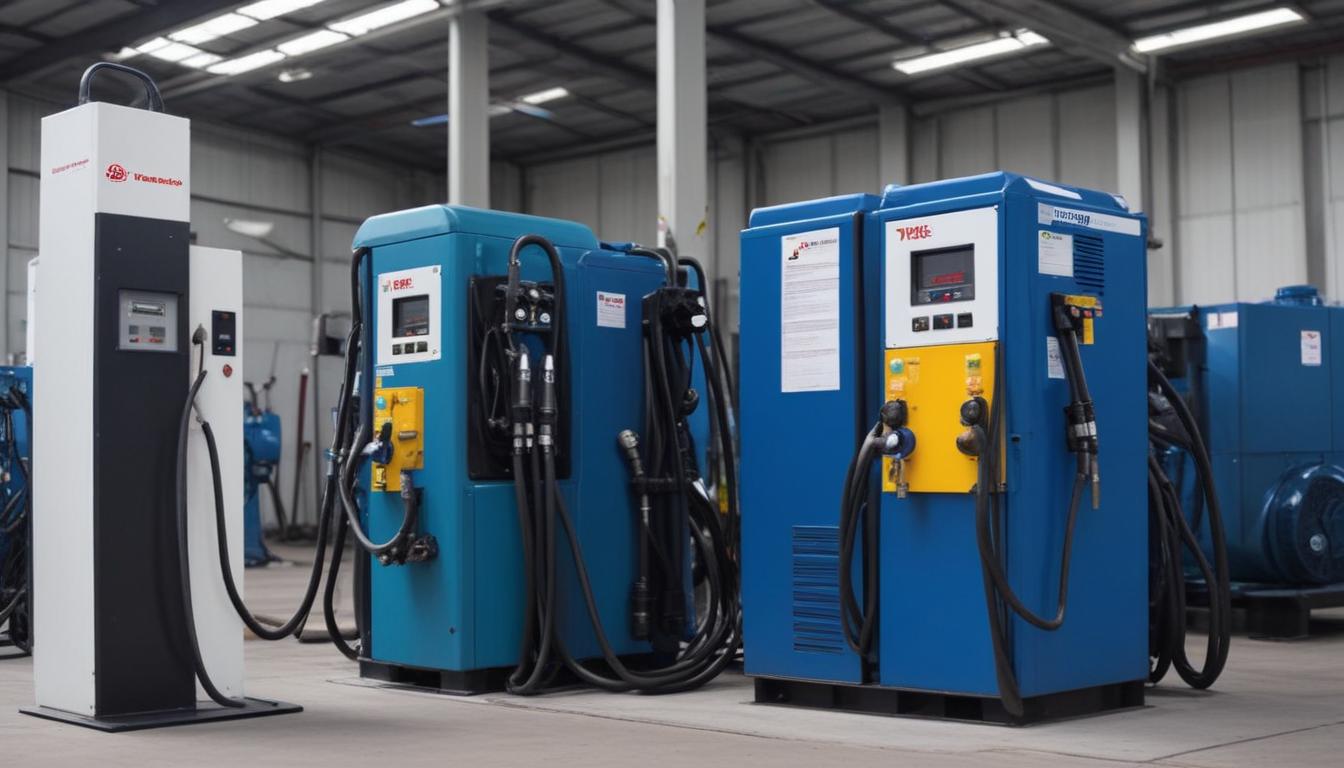 Electric pumps offer significant environmental advantages over diesel pumps, primarily due to their cleaner operation and compatibility with renewable energy sources. Electric pumps produce no direct emissions during operation, which substantially reduces their impact on air quality and greenhouse gas emissions. This characteristic makes them ideal for applications in sensitive environments, such as urban areas and protected natural sites, where minimizing pollution is crucial. Additionally, electric pumps can be powered by renewable energy sources like solar or wind, further decreasing their carbon footprint and promoting sustainability.
Electric pumps offer significant environmental advantages over diesel pumps, primarily due to their cleaner operation and compatibility with renewable energy sources. Electric pumps produce no direct emissions during operation, which substantially reduces their impact on air quality and greenhouse gas emissions. This characteristic makes them ideal for applications in sensitive environments, such as urban areas and protected natural sites, where minimizing pollution is crucial. Additionally, electric pumps can be powered by renewable energy sources like solar or wind, further decreasing their carbon footprint and promoting sustainability.
In contrast, diesel pumps emit various pollutants, including carbon dioxide (CO₂), nitrogen oxides (NOₓ), and particulate matter, as a result of the combustion process. These emissions contribute to air pollution, climate change, and adverse health effects, underscoring the environmental drawbacks of diesel-powered systems. The reliance on fossil fuels not only exacerbates greenhouse gas emissions but also ties diesel pumps to the volatility of fossil fuel markets and the finite nature of these resources.
| Environmental Impact Aspect | Electric Pumps | Diesel Pumps |
|---|---|---|
| Air Emissions | Zero direct emissions during operation | Significant emissions of CO₂, NOₓ, and particulates |
| Carbon Footprint | Lower, especially when powered by renewable energy | Higher due to fossil fuel combustion |
| Noise Pollution | Quieter operation with minimal noise | Higher noise levels from engine operation |
| Resource Dependency | Can utilize diverse and renewable energy sources | Dependent on diesel fuel, a non-renewable resource |
| Lifecycle Impact | Generally lower, with fewer harmful materials | Higher, including fuel extraction and engine disposal |
Electric pumps also contribute to reduced noise pollution, operating more quietly than their diesel counterparts. This is particularly beneficial in residential areas, hospitals, and other noise-sensitive environments where maintaining a quiet operational soundscape is essential. The quieter operation not only enhances the quality of life for nearby residents but also minimizes disturbances in workplaces and other settings where noise can be a distraction or a health hazard.
Moreover, the integration of electric pumps with renewable energy systems supports the transition towards a more sustainable and resilient energy infrastructure. By utilizing solar panels, wind turbines, or other renewable sources, electric pumps can operate with a significantly lower environmental impact compared to diesel pumps, which are inherently tied to fossil fuel consumption. This adaptability not only reduces dependence on non-renewable resources but also aligns with global efforts to combat climate change and promote energy independence.
- Electric Pumps:
- Contribute to lower greenhouse gas emissions.
- Operate silently, reducing noise pollution.
- Support the use of renewable energy sources.
- Have a smaller overall environmental footprint.
- Diesel Pumps:
- Emit harmful pollutants that degrade air quality.
- Produce significant noise, affecting nearby environments.
- Rely on non-renewable diesel fuel.
- Have a larger environmental footprint throughout their lifecycle.
The lifecycle environmental impact of both pump types further differentiates them. Electric pumps generally have a lower lifecycle impact, as they contain fewer harmful materials and require less intensive manufacturing processes compared to diesel pumps. Their components, such as electric motors and electronic controls, are often more recyclable and generate less hazardous waste at the end of their operational life. Additionally, advancements in electric pump technology continue to reduce the use of rare and environmentally damaging materials.
Conversely, diesel pumps entail a more substantial environmental burden throughout their lifecycle. The extraction, refining, and transportation of diesel fuel contribute significantly to environmental degradation and resource depletion. Furthermore, the disposal of diesel engines and related components poses challenges due to the presence of hazardous materials and the complexity of recycling heavy machinery. This lifecycle impact underscores the sustainability advantages of electric pumps over diesel-powered alternatives.
Regulatory Compliance and Future Trends: Increasingly stringent environmental regulations are favoring the adoption of electric pumps over diesel pumps. Governments and regulatory bodies worldwide are implementing policies to reduce emissions and promote cleaner energy sources, thereby incentivizing the transition to electric pumping solutions. This regulatory landscape is likely to drive further innovation and investment in electric pump technologies, enhancing their efficiency, reliability, and environmental performance.
In addition, the global shift towards sustainability and corporate responsibility is influencing businesses and industries to prefer electric pumps as part of their green initiatives. Organizations are recognizing the long-term benefits of reducing their carbon footprint and aligning with environmental goals, thereby choosing electric pumps to meet both regulatory requirements and corporate sustainability targets.
Overall, the environmental impact of electric pumps is markedly lower than that of diesel pumps, making electric pumps a more sustainable and eco-friendly choice. Their ability to operate without direct emissions, integrate with renewable energy sources, and maintain a smaller environmental footprint across their lifecycle positions electric pumps as the superior option in the ongoing comparison between electric and diesel pumping solutions.
cost analysis
Cost Analysis is a crucial factor when evaluating the financial implications of electric pumps versus diesel pumps. This comparison encompasses initial capital investment, installation expenses, operational costs, maintenance expenditures, and the total cost of ownership over the pump’s lifespan.
Initial Capital Investment:
Electric pumps generally require a higher initial investment compared to diesel pumps. This is attributable to the cost of electric motors, control systems, and potential integration with existing electrical infrastructure. However, advancements in electric pump technologies and economies of scale are gradually reducing these costs.
In contrast, diesel pumps typically have a lower upfront cost. The internal combustion engines used in diesel pumps are widely available and often cheaper to procure initially, making diesel pumps an attractive option for operations with limited initial capital.
Installation Costs:
The installation of electric pumps can involve additional expenses related to electrical infrastructure, such as wiring, circuit breakers, and possibly transformers, depending on the power requirements. These costs can be significant, especially for large-scale operations requiring high-capacity electric pumps.
Diesel pumps, on the other hand, tend to have lower installation costs. They can be deployed quickly with minimal infrastructure, making them suitable for temporary applications or sites without existing electrical systems.
Operational Costs:
Operational costs between electric and diesel pumps vary significantly, primarily influenced by energy prices and efficiency.
- Electric Pumps:
- Generally lower energy costs due to higher energy conversion efficiency (~90%).
- Electricity prices are typically more stable and predictable compared to fuel prices.
- Potential savings from integrating renewable energy sources.
- Diesel Pumps:
- Higher fuel costs driven by lower energy conversion efficiency (35-40%).
- Vulnerable to fuel price volatility and supply chain disruptions.
- Additional costs associated with fuel storage and handling.
Maintenance Expenses:
Maintenance costs are generally higher for diesel pumps due to the complexity of internal combustion engines.
- Electric Pumps:
- Lower maintenance requirements with fewer moving parts.
- Reduced need for consumables like oil and filters.
- Longer intervals between maintenance activities.
- Diesel Pumps:
- Higher maintenance frequency due to engine wear and tear.
- Costs associated with regular oil changes, filter replacements, and engine repairs.
- Need for skilled technicians to perform maintenance.
Total Cost of Ownership (TCO):
When evaluating the total cost of ownership, which includes initial, installation, operational, and maintenance costs over the pump’s lifespan, electric pumps often emerge as more cost-effective in the long run despite their higher upfront costs.
Comparison of Total Cost of Ownership:
| Cost Aspect | Electric Pumps | Diesel Pumps |
|---|---|---|
| Initial Purchase Cost | Higher | Lower |
| Installation Cost | Higher due to electrical infrastructure | Lower, minimal infrastructure needed |
| Operational Cost | Lower energy costs with high efficiency | Higher fuel costs with lower efficiency |
| Maintenance Cost | Lower maintenance requirements | Higher maintenance and repair costs |
| Total Cost of Ownership (Over Lifespan) | Lower due to reduced operational and maintenance expenses | Higher due to ongoing fuel and maintenance costs |
Return on Investment (ROI):
Electric pumps, while requiring a greater initial investment, offer a faster return on investment through lower operational and maintenance costs. The high energy efficiency and the stability of electricity prices contribute to steadily decreasing operational expenses, allowing for long-term savings that offset the initial higher costs.
Diesel pumps, with their lower upfront costs, may present a quicker initial deployment but tend to incur higher ongoing expenses. The variability in fuel prices and higher maintenance requirements can erode potential savings, resulting in a longer period to achieve ROI.
Financial Incentives and Rebates:
Another consideration is the availability of financial incentives and rebates for electric pump installations. Many governments and organizations offer subsidies, tax credits, or grants to promote energy-efficient and environmentally friendly technologies. These incentives can significantly reduce the initial capital investment required for electric pumps, enhancing their financial attractiveness compared to diesel pumps.
Scalability and Future-Proofing:
Investing in electric pumps also aligns with future trends towards sustainability and the increasing shift towards renewable energy sources. As energy markets evolve and renewable energy becomes more prevalent and cost-effective, the operational benefits of electric pumps are likely to become even more advantageous. This future-proofing aspect can lead to additional cost savings and ensure the longevity and relevance of the pumping system.
Economies of Scale:
Electric pumps benefit from economies of scale, particularly in larger installations where the cost per unit of power decreases as the system size increases. Bulk purchasing of electric components and streamlined installation processes can further reduce costs, making electric pumps increasingly competitive for large-scale applications.
Diesel pumps, while scalable, do not benefit to the same extent from economies of scale. The cost per unit remains relatively stable regardless of system size, which can make large-scale diesel pump installations less cost-efficient compared to their electric counterparts.
Energy Price Trends:
Electricity prices have historically been more stable than diesel fuel prices, providing greater predictability in operational budgeting. Additionally, the global push towards renewable energy is expected to drive down electricity costs further, enhancing the cost-effectiveness of electric pumps over time.
Conversely, diesel fuel prices are subject to significant fluctuations influenced by geopolitical factors, supply chain disruptions, and market demand. This volatility can lead to unpredictable operational costs, making long-term financial planning more challenging for diesel pump operations.
Depreciation and Tax Benefits:
Electric pumps may offer favorable depreciation schedules and tax benefits in many jurisdictions, further enhancing their financial attractiveness. Investments in energy-efficient technologies are often incentivized through accelerated depreciation or tax credits, reducing the effective cost of ownership.
Diesel pumps typically do not receive the same level of tax incentives, potentially increasing the overall cost of ownership when such benefits are factored in.
Conclusion:
In the comparison between electric and diesel pumps, the cost analysis demonstrates that electric pumps, despite higher initial costs, typically offer lower total cost of ownership through reduced energy consumption and maintenance expenses. The potential for lower operational costs, combined with the availability of financial incentives, makes electric pumps a financially viable and sustainable choice for many applications. Diesel pumps, while advantageous in scenarios requiring lower initial investments and greater portability, often result in higher long-term costs due to fuel and maintenance expenses.

